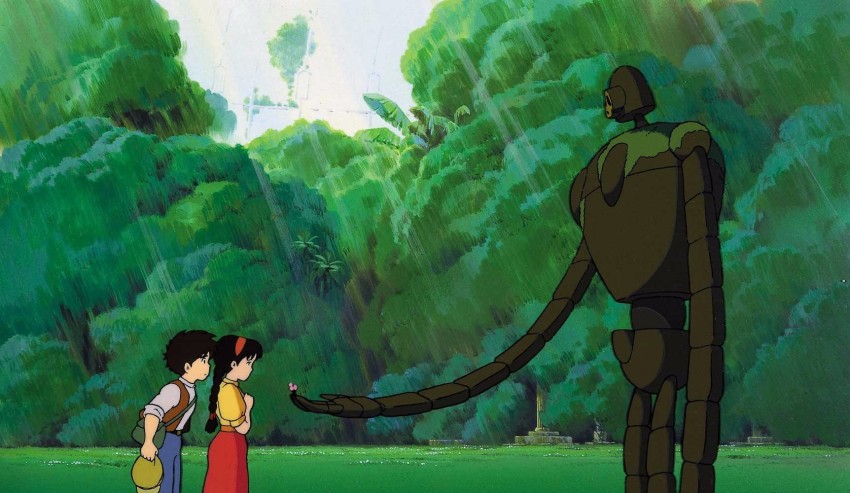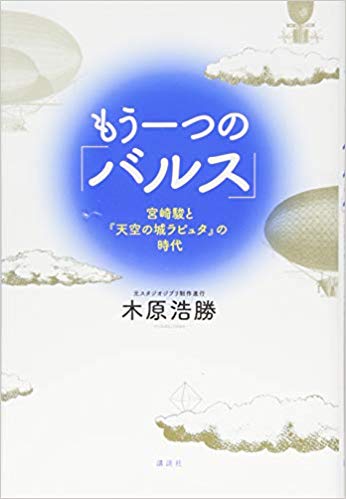Books: Another Balse
February 20, 2019 · 1 comment
By Motoko Tamamuro.
 Hayao Miyazaki was initially unaware of the phenomenon of the “Balse Festival” that broke out on social media. The Balse was the spell of destruction, cast by the protagonists Pazu and Sheeta in Studio Ghibli’s first official production, Laputa: The Castle in the Sky. Over the years, fans in Japan began tweeting the word “Balse” when the film was shown on TV, leading to a mass internet event in 2016, when to mark the 30th anniversary of the film, an onscreen countdown urged everybody to tweet at once. At the moment the characters uttered the magic word, the Japanese twittersphere blew up with 345,000 messages, all tweeting the same mystic term.
Hayao Miyazaki was initially unaware of the phenomenon of the “Balse Festival” that broke out on social media. The Balse was the spell of destruction, cast by the protagonists Pazu and Sheeta in Studio Ghibli’s first official production, Laputa: The Castle in the Sky. Over the years, fans in Japan began tweeting the word “Balse” when the film was shown on TV, leading to a mass internet event in 2016, when to mark the 30th anniversary of the film, an onscreen countdown urged everybody to tweet at once. At the moment the characters uttered the magic word, the Japanese twittersphere blew up with 345,000 messages, all tweeting the same mystic term.
Recognising a profound history and love of the film in Japan, the film’s former production assistant Hirokatsu Kihara eventually wrote a book to mark the anniversary. Laputa was the first Ghibli film, following on from the same crew’s earlier non-Ghibli success, Nausicaä. Kihara was one of the staff members there from the very start. Shortly after graduating from the Osaka University of Arts, he visited the Topcraft company in Tokyo to interview for a filming assistant’s job. Kihara was passionate about animation, and determined to work for the company that had made Nausicaä, which legendarily did almost everything in-house. But he was too late – firstly because he accidentally showed up a day after his scheduled meeting, but also because Miyazaki had already left the company.
 Regardless, Kihara talked himself into the position, volunteering for the super-tough filming assistant’s job, the last process of film production and so inevitably the one that inherits all of the collapsed deadlines and overnight pushes. His book depicts the high-stress environment of minions shouted at by their panicking bosses, and a revolving door of quitting staff. But Kihara stays put, gritting his teeth and hoping against hope that one day he might get to work with Miyazaki. After a year, Topcraft shuts its doors for good, but the managing director Toru Hara, offers to help him out – a new company is being set up, and he lets him know that this one, Ghibli, is going to be the magic ticket.
Regardless, Kihara talked himself into the position, volunteering for the super-tough filming assistant’s job, the last process of film production and so inevitably the one that inherits all of the collapsed deadlines and overnight pushes. His book depicts the high-stress environment of minions shouted at by their panicking bosses, and a revolving door of quitting staff. But Kihara stays put, gritting his teeth and hoping against hope that one day he might get to work with Miyazaki. After a year, Topcraft shuts its doors for good, but the managing director Toru Hara, offers to help him out – a new company is being set up, and he lets him know that this one, Ghibli, is going to be the magic ticket.
Kihara’s book focusses on his life at Ghibili – “life” being the operative word, because the studio soon consumes all his waking moments, and often becomes the place where he speaks. He depicts the master’s job from the point of view of his young, inexperienced but ardent staff. An unpretentious read, it allows his passion and naivety to shine through, trumping many other Ghibli books by including revealing dialogues between Kihara and Miyazaki himself. “How does Laputa float?” he innocently asks Miyazaki one day, commencing a series of friendly conversations about the mechanics of Miyazaki’s fantasy worlds.
One evening, Miyazaki stops him to ask: “Hey, Kihara-san, have you read Dune? What do you think?” Kihara soon realised he was asking about the ornithopter flying craft in the book. ‘Dune? I have read it. Are you talking about performance? Comfort?’ Miyazaki’s face brightens up. ‘Yes! Comfort! Because [Frank Herbert] was a novelist he wrote a bird-style ornithopter. But if you ride in something like that for real, though, every time the wings crank up and down, people bounce around all the time, banging on the ceiling and the floor all the time. It would be impossible to ride. So if we want to make an ornithopter, it would be better to come up with one that worked like an insect, although it is technically impossible.’ Because it is impossible to create an insect-style flying machine in real life, Kihara thinks Miyazaki wants to do it in the anime. Laputa was born to show off the Flappter.
Miyazaki is already working on the third of four acts when he suddenly shows Kihara a storyboard, introducing a new character. Kihara is troubled that a new face gets introduced so late in the film, but Miyazaki has a plan. “This man is the creator of the Flappter,” he explains. “This man is a priest and a scientist. The young Dola recognised his talent and kidnapped him. The Flappter is a technology he creates while working for her.” He hands Kihara a storyboard making it clear that the Flappters were not made with Laputa technology, but created by this mystery inventor, listed as a priest and also as Dola’s lover. It is a lovely backstory, but even Miyazaki admits that a character can’t be introduced so late – Kihara thinks he is being shown this off-cut because Miyazaki needs someone to tell him it can never be used in the film.
Other out-takes turn this book into a treasure trove of the Laputa that could have been. Kihara writes himself into the narrative as Miyazaki’s inadvertent sounding board, ably demonstrating the growing pains of a creator trying to fashion something entirely new. This kind of pressure never shows up on screen – it all looks so effortless, but Kihara shows Miyazaki’s working process in detail.
Miyazaki’s storyboards were not completed until four months before the film’s theatrical release. Production was already underway, but there was still a huge rush to get the film to the theatres on time. His hair, formerly black, had turned completely white by the end of it. It is only when the film is safely delivered that Kihara finally takes a day off, the first since he started working at Ghibli.
Another “Balse”: Hayao Miyazaki and the Era of Laputa: The Castle in the Sky by Hirokatsu Kihara is currently only available in Japanese.
anime, books, Castle in the Sky, Ghibli, Hayao Miyazaki, Hirokatsu Kihara, Japan, Laputa, Motoko Tamamuro, Studio Ghibli
Ruben (@_Blackiris)
May 26, 2019 12:45 pm
Thank you for your impressions (also of the Totoro book). I got this book and it’s a lot of fun to read. I really like Kihara’s writing style. Once I finish this, I will also get the Totoro book.